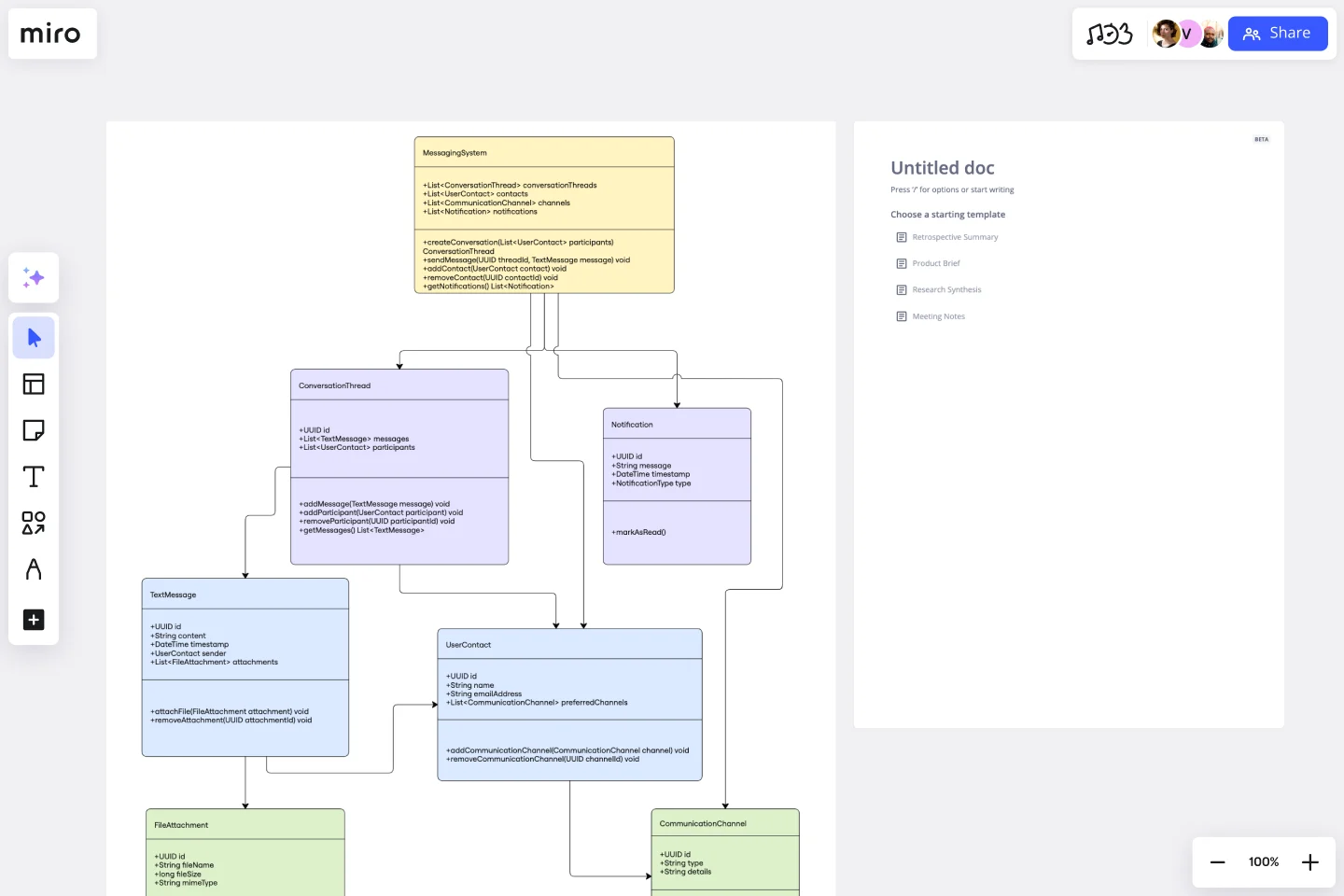UML Class Messaging System Template
Provide a structured visual framework that simplifies the complexity of messaging systems with the UML Class Messaging System Template.
Available on Enterprise, Business, Education plans.
About the UML Class Messaging System Template
The UML Class Messaging System Template is designed to fully visualize a messaging system's functionality. This template helps in managing various aspects of a messaging system, including text messages, conversation threads, user contacts, notifications, and channels. It provides a clear visual representation of how all these elements interact within the system, making it an invaluable tool for system designers and developers aiming to understand or convey the structure and dynamics of messaging systems.
How to use the UML Class Messaging System Template
Edit the template: After adding the template to your board, you can start customizing it to fit your specific project needs. You can modify the classes, attributes, methods, and relationships to accurately represent the messaging system you are designing or analyzing.
Collaboration: Invite your team to collaborate on the diagram in real-time or asynchronously. Discuss, edit, and refine the diagram together, ensuring a comprehensive understanding and agreement on the system's design.
Review and iterate: Use Miro's commenting to gather input from stakeholders or team members. Iterate on the design as needed based on the feedback received to ensure the final diagram accurately represents the intended messaging system architecture.
Why use the UML Class Messaging System Template
Using the UML Class Messaging System template in Miro has several advantages:
Efficiency: Quickly get started with a structured visual representation, saving time on initial setup.
Clarity: Provides a clear and detailed overview of the messaging system's architecture, making it easier to identify potential issues or improvements.
Collaboration: Facilitates effective team collaboration and stakeholder engagement, ensuring all voices are heard and considered in the design process.
Flexibility: Easily customizable to fit the unique requirements of your project. Whether you're designing a simple messaging app or a complex communication platform, the template can be adapted to suit your needs.
Visual clarity: The template provides a visual framework that simplifies the understanding of complex messaging systems. By mapping out classes, attributes, methods, and relationships, stakeholders can easily grasp how different components interact.
Improved communication: It serves as a common language for developers, designers, and stakeholders, facilitating clearer communication. The visual representation helps in bridging the gap between technical and non-technical team members, ensuring everyone is aligned.
Error reduction: Early visualization of the system architecture can help identify potential issues or inefficiencies, reducing errors in the development phase. This proactive approach saves time and resources in the long run.
Documentation and reference: The completed diagram can serve as valuable documentation for current and future development efforts. It provides a reference point for understanding the system's structure and can be used to onboard new team members or guide future expansions.
Get started with this template right now. Available on Enterprise, Business, Education plans.
Genogram Template
Works best for:
Diagramming
The Genogram Template maps out family structures and relationships with exceptional depth and detail. Unlike traditional family trees, this template provides a comprehensive perspective by encapsulating familial connections, emotional ties, and significant life events. Create a genogram to unearth patterns and trends within a family, whether hereditary or environmental. Professionals across different domains can gain a holistic understanding of familial dynamics by showing deep insights into the nuances of relationships, facilitating better communication and problem-solving.
Business Plan Mind Map Template
Works best for:
Strategy, Planning
The Business Plan Mind Map Template simplifies complex business information by visually organizing each plan section as a branch on a mind map. This enhances communication, understanding, and attention to crucial aspects, making it an essential tool for developing effective business strategies.
666 Roadmap Template
Works best for:
Strategic Planning, Product Management
For most companies, especially startups, it’s important to keep two perspectives in mind when planning for the future: your plan and your vision. Your plan is a close-up view of what you want to accomplish in the near future, while your vision provides a zoomed-out view of what you hope to accomplish in the long term. The 666 Roadmap encourages you to plan for the future by thinking about the next 6 years, 6 months, and 6 weeks. Use this roadmap to strategize, think about what you want to build, and focus on a concrete plan for the upcoming quarter.
UML Sequence E-commerce Checkout Template
Works best for:
UML
The UML Sequence E-commerce Checkout Template in Miro is a versatile tool for visualizing and analyzing e-commerce checkout processes. It provides a step-by-step visual representation of system interactions, is highly customizable, supports real-time collaboration, and is suitable for various e-commerce platforms. It serves as an efficient documentation tool, fosters team collaboration, and contributes to a more streamlined checkout experience for customers.
Project Timeline Builder
Works best for:
Timeline, Planning
The Project Timeline Builder template is a powerful tool for planning and managing project timelines. It helps you break down projects into manageable tasks, set deadlines, and track progress. This template ensures you stay organized and meet your project goals efficiently.
UML Use Case Online Shopping System Template
Works best for:
UML
The Online Shopping System Template simplifies the process of documenting and visualizing how users interact with an online shopping system. It provides a standard way to map out user interactions, such as product listings, inventory management, shopping carts, order processing, payments, and shipping details. By using this template, teams can collaborate effectively in real-time or at different times, adjusting the diagram to meet their project's specific needs. This not only improves clarity and efficiency but also fosters better communication among team members and stakeholders, ensuring a thorough understanding of the system's design and requirements.
